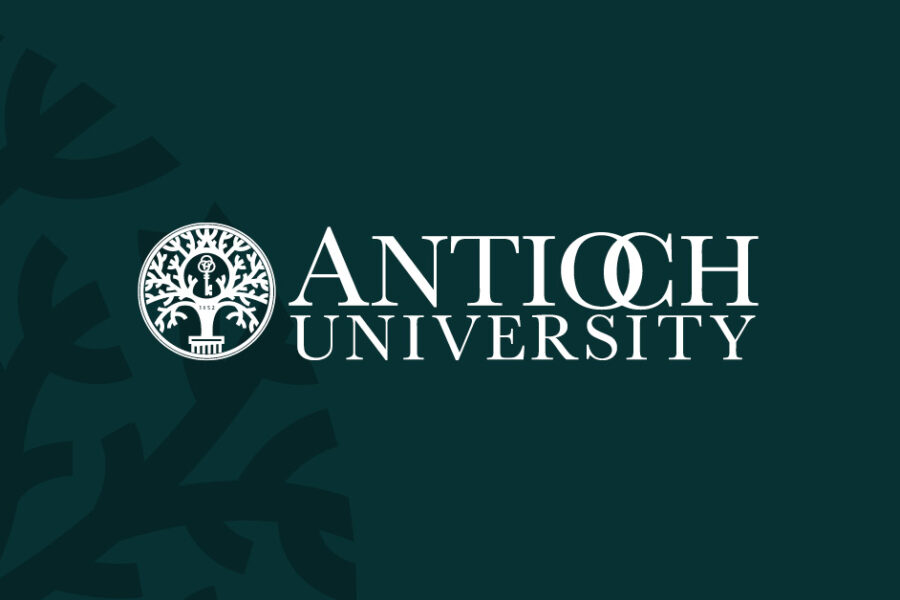When Melissa Kirk joined Antioch University’s leadership team in early 2020, she was excited to visit all of Antioch’s campuses—to meet various faculty and staff and get to know some of the students who she would be advocating for in her new role as Assistant Vice Chancellor for Student Success. Early in March, she visited Antioch Los Angeles and spent a few days on campus in advance of a scheduled meeting of Antioch’s Board of Governors in Santa Barbara.
Then, seemingly overnight, it became clear that the fast-spreading disease known as COVID-19 would require extraordinary measures. The board meeting was canceled. Kirk flew back to New York City just as the nation entered a months-long hibernation. And by March 18, Antioch Los Angeles had closed its campus.
It’s now almost two years later, and it’s unclear whether things will ever return to a pre-pandemic norm. For Kirk, her time so far at Antioch has been busy, and almost entirely conducted over Zoom calls. “I haven’t even been to Seattle,” she says. But regardless of whether she’s visited every campus, Kirk in her new role as Associate Vice Chancellor for Academic Affairs has had a front-row seat to see the work of many dozens of people across the university—everyone coming together to support student success in an unprecedented time.
Now, two years after the pandemic transformed life in America, Antioch continues to adapt to an ongoing public health crisis. The University Reopening Taskforce is working hard to find safe, workable ways to get Antioch students who want to study in person back onto campuses. But even as we move forward, it’s important to notice and reflect on the university’s response to the crisis, to remember some of the many ways that people stepped up with creativity and energy and flexibility, and to explore how Antioch is prioritizing student success moving forward.
Bringing Support Directly to Students
One of the main ways that Antioch has supported its students throughout the pandemic is through a combination of direct financial support and reduced costs. The university distributed over $3 million in federal relief funds directly to students with exceptional need. This funding—a giant infusion that went straight to the neediest—helped keep many Antioch students enrolled and moving forward in their studies.
In addition, at the very beginning of the crisis the University’s Chancellor Bill Groves established the Student Emergency Aid Fund, which used internal university funds to give grants of up to $2,000 to struggling students—aid that was often approved within 24 hours. “We didn’t know how many people might lose their jobs, how many people might lose housing or not be able to pay rent, or cover essentials like food and childcare and any number of things,” says Kirk. “So the Chancellor’s Emergency Fund was really critical.”
A more universal $250 discount was offered to every student who enrolled for a course in the summer of 2020. Kirk explains that, as this was only a fraction of most tuition, this was more of a “symbolic” gesture. Nevertheless, it sent a message that the university wanted to help all of its students during a hard time. And the university gave students the option to decline the discount and direct those funds instead to a student in need. 143 Antioch students elected to do just that, and by opting out they freed up $35,750 dollars in aid for their classmates.
At this same time, campus provosts and program chairs were asked to consider whether any course fees or other student costs might be eliminated during the period of the crisis, which resulted in numerous changes to reduce students costs.
Other forms of support had more to do with the way procedures could be redesigned on the fly to keep students from dropping out or falling behind in their schoolwork during such a tumultuous time. The university made the early decision not to cancel any classes even as it rapidly brought those classes into an online modality. Kirk says that it “certainly helped” that Antioch had “a long tradition of remote work and successful low-residency, hybrid, and fully-online programs.”
At the same time, no students were withdrawn for failure to attend classes. And even in cases where students didn’t finish their work for a course, instead of automatically giving the student a grade of “incomplete” the university instead assigned the grades as “in progress,” giving students more time to finish their work. Explains Kirk, “We did everything that we could, that was allowable under federal regulations, to minimize harm to students and to make sure that there wasn’t any interruption in their studies.”
Creating Virtual Help Desks To Help With the Transition Online
Another way that students have been supported over the last two years is through the creation of “Virtual Front Desks” taking the place of the admissions offices, student services centers, and campus services areas that help students on a drop-in basis. These virtual front desks were set up as Zoom rooms. Says Sandy Lee, the Chief Operations Officer at Antioch Los Angeles, who set up the first of these rooms, “These virtual resources have provided students with the ability to connect with people and programs for assistance, and have provided students with the ability to connect in real-time with staff who are here to help.” Lee also saw up the creation of a virtual directory that was distributed widely to students.
One of the major ways that this help took shape in the early days was as staff helped less tech-savvy students get set up for school in a virtual environment. “For some students,” says Lee, “transitioning to remote instruction was a big technical hurdle.” Being able to pick up the phone or drop by virtual offices for assistance was a help. All of this sought to address and remedy the fact that, as Lee says, “For many, the move to virtual learning was an isolating shift from the education they signed up for.”
The sorts of help that students can get by accessing these services are various: students need help registering for classes, they desire guidance in understanding program requirements, they are unsure of how to contact the Financial Aid Office, they don’t know how to find a course reader, and a million other questions both big and small. “Every time a student drops in on a virtual front desk and gets the help they are looking for,” says Lee, “it’s very rewarding for us as a team.”
The project of providing this level of service took the attention and dedicated effort of managers from many different areas coming together to devise standard protocols and figure out how to best use the technology. “We could not have served students the way that we did,” says Kirk, “without everybody coming together and making the environment more flexible.”
For Lee, the biggest thing is providing a high quality of service to all students. As she says, “It is important that our students can get high-touch, on-demand help during their studies, and to be able to provide this level of service while the campus is closed has been a real victory.”
Moving Internship Sites Online
Another key change that had to be implemented swiftly was bringing the internship sites that serve Antioch’s many mental health professionals-in-training from a physical into a virtual format. This was especially important because for graduates to become licensed therapists, counselors, and psychologists they are required to complete a certain number of hours of supervised practice. But prior to the pandemic, almost all of these sites where such supervision could occur were in-person.
At Antioch Los Angeles, within months a new program called Antioch Community Therapy Services (ACTS) was launched, offering free therapy to Californians fourteen and older who had been impacted by the pandemic. This initiative was first proposed by a student, Lane Janger, who helped develop the plan on a radically shortened time frame together with faculty member Susan Schuster-Bacon, who served as ACTS’s first Clinical Director.
Meanwhile in Seattle Doug Wear, the longtime Director of Antioch’s Community Counseling and Psychology Clinic, moved quickly to bring the site into a virtual format. They began offering free counseling to frontline health workers; for others it was on a sliding scale.
Through these and other efforts, the licensure of hundreds of graduates was preserved—something key not only to these students’ professional prospects but also to widening the availability of high-quality mental healthcare in a time when demand surged. (To learn more about how Janger and Wear accomplished these big changes, listen to the joint interview with them on Antioch’s Seed Field Podcast.)
Ongoing Efforts and Services Center Student Success
The work of responding to such big changes as those wrought by the COVID-19 pandemic is ongoing. In some ways, the university has taken advantage of this time to build processes that will benefit students for a long time to come. One example is the innovation of biannual Student Success Symposia. In the spring of 2021, Kirk along with Andrea Richards, Karen Crist, and a 25-person planning committee helped launch the inaugural Antioch University Student Success Virtual Symposium, a one-day event that sought to explore ways that the university can better support student success. The event was well-received. Says Kirk, “It was very well attended and marked the first time the AU community came together to discuss student success.”
Last fall the organizers held another symposium, this time a two-day event that brought nearly 200 students, staff, administrators, and faculty together. This second symposium’s theme was “Listening & Being Heard: Building Authentic Relationships that Enhance Student Growth and Empowerment.” Through seven different presentations and workshops, participants worked together to find ways to better serve our students. Currently, organizers are planning the third Student Success Symposium for this spring, which will have the theme of “Diversity, Equity, and Inclusion.” They are soliciting proposals for presentations and workshops from stakeholders across the university.
Another development is the launch of WellConnect, a well-being program that provides students and their families with free access to counseling, referrals for local resources, and consulatations on finances, legal needs, health, and wellness. “That’s the last critical piece,” says Kirk. The urgent need for mental health treatment has “been exacerbated by the pandemic,” she explains, “but there’s a need for it regardless of whether or not we’re in a pandemic.”
And this is a theme running through all discussions of Antioch’s response to the pandemic and plans moving forward: how to preserve and build on the lessons learned during a time of suffering and difficulty but also rapid adaptation and big steps forward. As the Campus Reopening Taskforce works towards a full resumption of on-campus instruction, it’s clear that Antioch will never be precisely the same as it was in February, 2020. The hope is that it will be, in some major ways, better.




